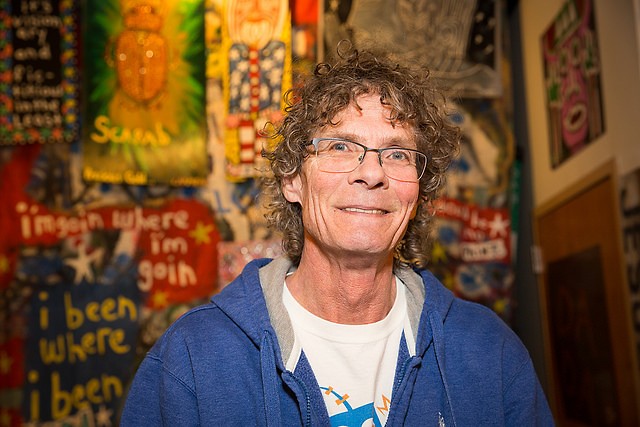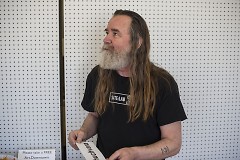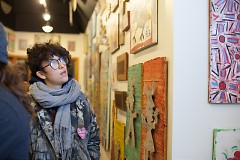When you first walk into Sanctuary Folk Art, you are immediately surrounded by an explosion of color as you first take in the amazing variety of art lining every inch of possible space on the wall. While the gallery hosts up to 40 different artists at any time, many of the pieces on the walls are painted and made by Reb Roberts, a prolific artist who has been running Sanctuary Folk Art on South Division since 1999. On the other end of the South Division corridor, the 337 Project Space stands in stark contrast as a study in minimalism, almost spartan in comparison. When curating his space, owner Tom Duimstra is laser-focused on highlighting each piece of art for a full appreciation of the artist’s work.
Duimstra and Roberts are longtime artists and friends who have been affiliated with the South Division art scene for nearly two decades. They have witnessed the arts community evolve and grow, eventually adopting the community chosen title, the Avenue for the Arts. Both artists have remained heavily involved, creating art and curating shows in their respective galleries. When asked why he’s chosen to stay connected to the area for so long, Duimstra answered, “I’m from this area, and the Avenue is where the artists have been for many years. This is the area of Grand Rapids where many artists live and work, and it’s relatively affordable. It’s really the only pocket in Grand Rapids where artists converge consistently.”
Roberts echoed the sentiment that the Avenue was a hub for artists where “there was some recognition, real acknowledgement that there was a real arts community and that artists may want to live in an area in close proximity to each other. That was a big step on the part of the city and Dwelling Place as a property owner, and artists too!”
Both 337 Project Space and Sanctuary Folk Art have been longtime staples of First Fridays, showing art during monthly exhibitions. Duimstra reflected on the shows featured at 337 Project site: “All of the exhibits that have shown in my space over the past couple of years have been memorable, in my opinion. I always wanted to have the resources to feature the work of artists that I respect, and each monthly show has been successful and memorable in different ways.”
In addition to featuring artists and showing their own artwork, Duimstra and Roberts have both worked on creating public artworks in and around South Division. Public art is arguably one of the most important parts of a city’s culture. Alexander Calder’s “La Grande Vitesse” is even seen as a symbol of Grand Rapids, as it is represented on our city’s official logo and can be viewed on many street signs around our city.
In Reb’s experience, “Amazing things would happen just by putting artwork in a neighborhood, so I’m glad that we’ve had the opportunity. And most everything we’ve done in this neighborhood has been a collaborative thing with an organization, or with a group of artists, so that’s been the good thing…and agencies and funders jumping on board to help that happen.” Duimstra adds, “It's free, it belongs to everyone. You don't have to pay to participate and interact with it...you can come as you are. It becomes part of the culture. Hopefully, a city cultivates public art to further its distinct flavor and culture. It speaks to what the city represents, or aspires to represent. It affects people in one way or another, whether they realize it or not.”
The Heartside Neighborhood and Avenue for the Arts corridor have undergone significant change over the last few decades. However, the neighborhood still faces difficult issues that don’t have any simple solution. Roberts’ frustration with South Division’s progress is that the community improvement takes people getting involved and staying involved. “I stuck around hoping to make some changes…but after 18 years of trying to address the same concerns sort of makes us look pretty silly after awhile.” He hopes that nonprofits, city staff and residents are committed to continue to making change.
On the challenges that South Division faces, Duimstra asserts, “As always, it will be sustainability, affordability.... basically how to survive and coexist with gentrification, poverty, the homeless, and the drug dealers who exploit a lot of the homeless who live on the Avenue. The artists sometimes get stuck in the middle of all of that. When improvements are made, rents increase, and this narrows the audience that can even entertain the idea of setting up a gallery, studio or business on the avenue. At the same time, there are still a number of people who feel uncomfortable venturing too far down the Avenue because they may encounter people who push them out of their comfort zone.”
When asked what his hopes for the creative community are, Duimstra answers, “I hope it continues to expand its vision, and that artists and arts organizations become even more willing to take creative risks. It would be great if the progressive community expanded in GR, because I feel that will allow the art scene to evolve and progress. It's not necessarily about size, but scope of ideas, willingness to take risks, not being as concerned with the bottom line of making money, and bringing in projects simply because they enhance the community.”
Roberts and Duimstra both have exhibitions open during July First Fridays and August First Fridays and welcome new artists and gallery goers at Sanctuary Folk Art and 337 Project Site respectively. Join Avenue for the Arts members and artists for a discussion about the artist's role in resisting gentrification (based on a recent HyperAllergic Article) on July 6th from 6-8 p.m.
The Avenue for the Arts is a neighborhood title for the South Division commercial corridor. We are residential, commercial and nonprofit groups working together in a creative community. We are residents in Heartside, and active participants in shaping change in our neighborhood. In 2005, we choose the Avenue for the Arts as a title to represent our commercial corridor and the projects and events that we create. Because the Avenue is powered by volunteers guest writers create our Rapidian content. Special thanks to Justin MacAuley for his contribution of this piece. Justin is an Avenue member, First Fridays Coordinator, self-taught illustrator, sculptor, and 2015 runner up to the runner up for the Mr. Kentucky Pageant.
The Rapidian, a program of the 501(c)3 nonprofit Community Media Center, relies on the community’s support to help cover the cost of training reporters and publishing content.
We need your help.
If each of our readers and content creators who values this community platform help support its creation and maintenance, The Rapidian can continue to educate and facilitate a conversation around issues for years to come.
Please support The Rapidian and make a contribution today.


